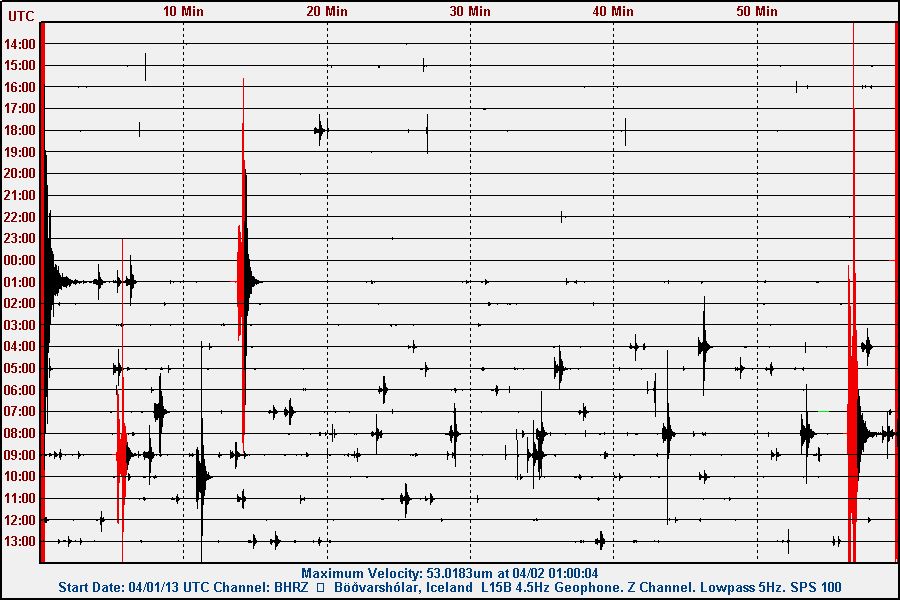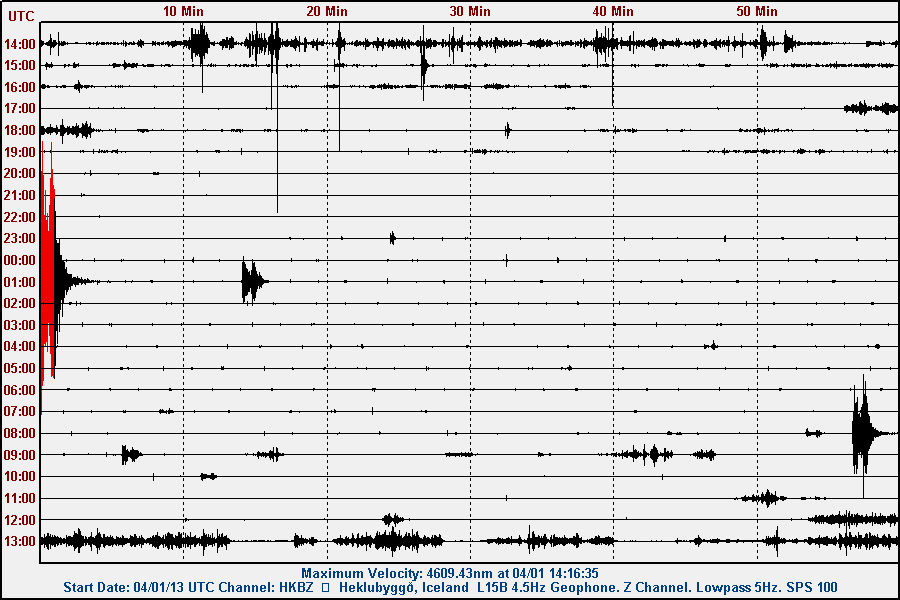This is a short blog post about the earthquake swarm in Tjörnes Fraction Zone.
The largest earthquake so far is a magnitude 5.5. The largest aftershocks so far are magnitude 4.4 that took place at 01:14 UTC and 4.7 that took place at 08:55 UTC this morning. This earthquake swarm is taking place on a complex fault area that is highly active. There is also big question what effect this earthquake swarm is going to have on other faults in the area. There is a risk that this earthquake swarm is going to start other earthquake swarms in nearby faults. Uncertainty level has been declared for area from Sauðárkrókur to Raufarhöfn at least. This is the largest earthquake in this area since the year 2002 and 2005. But both this years there was a magnitude 5.0 earthquakes in this area.

The earthquake activity in TFZ. Green stars are earthquakes that are larger then magnitude 3.0. Copyright of this image belongs to Icelandic Meteorological Office.

This trace shows how dense this earthquake swarm has been. Copyright of this image belongs to Icelandic Meteorological Office.

The earthquake is appearing clearly on my geophone network. This is Böðvarshólar geophone station. This image is released under Creative Commons licence. Please see the CC Licence page for more details.

The largest earthquakes as they did appear on Heklubyggð geophone station. This image is released under Creative Commons licence. Please see the CC Licence page for more details.
There have been over 500 earthquake recorded since this earthquake swarm did start. It is impossible to know for sure when this earthquake swarm is going to stop, or if it is going to pick up again. But the earthquake swarm is already starting to shown signs of dropping activity. But that might change again if there is new larger earthquake in this area, or swarm of larger earthquake.
I am going to post update of anything major happens in this earthquake swarm. It is possible to monitor the current status of this earthquake swarm here on my geophone web page.
Blog post updated at 15:23 UTC on 02.04.2013.
Blog post updated at 16:14 UTC on 02.04.2013.
Blog post updated at 16:26 UTC on 02.04.2013.

Has anyone estimated how much energy it has released so far. I believe the stresses in the area were already known before it happened.
Though I think someone said it could set off another fault then. Is IMO saying anything about the chances to Icelandic press, because I dont speak Icelandic so cowould appreciate being told what Icelandic press are saying.
There are some articles in English, but no special informations:
http://grapevine.is/Home/ReadArticle/Series-Of-Earthquakes-Hit-Grimsey
http://www.icelandreview.com/icelandreview/daily_news/Earthquake_Hits_Gr%C3%ADmsey_in_North_Iceland_0_399086.news.aspx
Thanks for that. I gather they don’t find it surprising, from the briefness of there coverage. That would be the main headlines if it happened in the UK
By the way: Found this site for GPS-Stations. Don’t know if it’s new:
http://gps.vedur.is/index.php?p=ts
I have not seen it before. Good find.
There is a new site about the FutureVolc-Projekt
http://futurevolc.hi.is/forsida
The link is from this site “Present day in-situ monitoring networks of volcanic and seismic hazards”.
How long can we expect this swarm to last?
Earthquake swarms in this part of TFZ can last from weeks to months in the longest.
This part of TFZ is also able to make earthquakes with the magnitude of 7.0. I am not sure when the last earthquake took place that was that big. I have to look it up.
Do you have focal mechanism all earthquake above Mw 4.0?
I am going to post the pictures that IMO has released about the earthquakes so far. There are a lot of earthquakes with the magnitude above 4.0.
There appear to be not many earthquakes elsewhere in Iceland. Is that because they are lost in the general rumble from TFZ and can’t be resolved, or are there really fewer?
There is not a lot happening in other parts of Iceland at the moment.